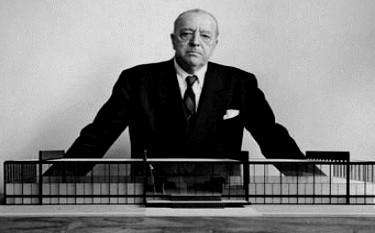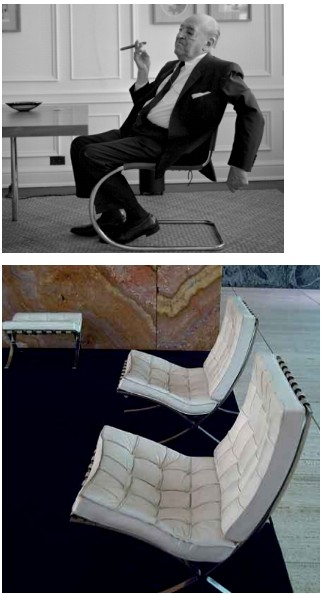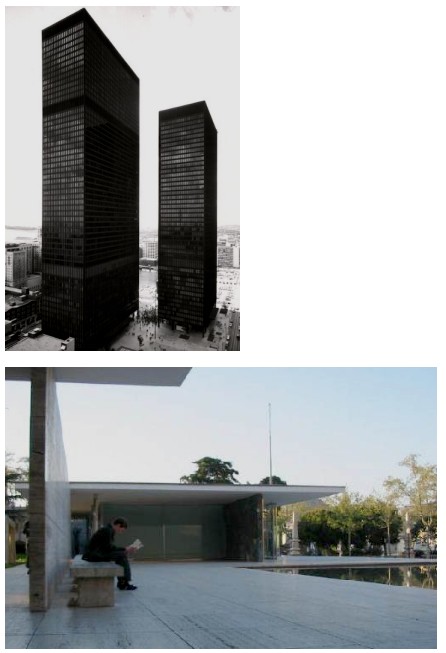考研阅读精讲(七)(下)
LESS IS MORE
2011 T3
路德维希·密斯·凡·德·罗(Ludwig Mies van der Rohe,1886年3月27日-1969年8月17日)生于德国亚琛,过世于美国芝加哥,原名为玛丽亚·路德维希·密夏埃尔·密斯(Maria Ludwig Michael Mies),德国建筑师,亦是最著名的现代主义建筑大师之一。

密斯·凡·德·罗的贡献在于通过对钢框架结构和玻璃在建筑中应用的探索,发展了一种具有古典式的均衡和极端简洁的风格。
其作品特点是整洁和骨架露明的外观,灵活多变的流动空间以及简练而制作精致的细部。

“细节就是上帝”

1 We tend to think of the decades immediately following World War II as a time of prosperity and growth, with soldiers returning home by the millions, going off to college on the G. I. Bill and lining up at the marriage bureaus.
2 But when it came to their houses, it was a time of common sense and a belief that less could truly be more. During the Depression and the war, Americans had learned to live with less, and that restraint, in combination with the postwar confidence in the future, made small, efficient housing positively stylish.
3 Economic condition was only a stimulus for the trend toward efficient living. The phrase “less is more” was actually first popularized by a German, the architect Ludwig Mies van der Rohe, who like other people associated with the Bauhaus, a school of design, emigrated to the United States before World War Ⅱ and took up posts at American architecture schools. These designers came to exert enormous influence on the course of American architecture, but none more so than Mies.
4 Mie’s signature phrase means that less decoration, properly organized, has more impact than a lot. Elegance, he believed, did not derive from abundance. Like other modern architects, he employed metal, glass and laminated wood — materials that we take for granted today but that in the1940s symbolized the future.
Mies’s sophisticated presentation masked the fact that the spaces he designed were small and efficient, rather than big and often empty.
5 The apartments in the elegant towers Mies built on Chicago’s Lake Shore Drive, for example, were smaller — two-bedroom units under 1,000 square feet — than those in their older neighbors along the city’s Gold Coast.
But they were popular because of their airy glass walls, the views they afforded and the elegance of the buildings’ details and proportions, the architectural equivalent of the abstract art so popular at the time.
6 The trend toward “less” was not entirely foreign. In the 1930s Frank Lloyd Wright started building more modest and efficient houses — usually around 1,200 square feet — than the spreading two-story ones he had designed in the 1890s and the early 20th century.
7 The “Case Study Houses” commissioned from talented modern architects by California Arts & Architecture magazine between 1945 and 1962 were yet another homegrown influence on the “less is more” trend. Aesthetic effect came from the landscape, new materials and forthright detailing.
In his Case Study House, Ralph Rapson may have mispredicted just how the mechanical revolution would impact everyday life — few American families acquired helicopters, though most eventually got clothes dryers — but his belief that self-sufficiency was both desirable and inevitable was widely shared.
31、The postwar American housing style largely reflected the Americans’ _______.
A. prosperity and growth
B. efficiency and practicality
C. restraint and confidence
D. pride and faithfulness
参考答案:C
32、Which of the following can be inferred from Paragraph 3 about the Bauhaus?
A. It was founded by Ludwig Mies van der Rohe.
B. Its designing concept was affected by World War I1.
C. Most American architects used to be associated with it.
D. It had a great influence upon American architecture.
参考答案:D
33、Mies held that elegance of architectural design ______.
A. was related to large space
B. was identified with emptiness
C. was not reliant on abundant decoration
D. was not associated with efficiency
参考答案:C
34、What is true about the apartments Mies built on Chicago’s Lake Shore Drive?
A. They ignored details and proportions.
B. They were built with materials popular at that time.
C. They were more spacious than neighboring buildings.
D. They shared some characteristics of abstract art.
参考答案:D
35、What can we learn about the design of the “Case Study Houses” ?
A. Mechanical devices were widely used.
B. Natural scenes were taken into account.
C. Details were sacrificed for the overall effect.
D. Eco-friendly materials were employed.
参考答案:B
考研视频教程:您可进入👉本站首页👈
更多考研讲义:您可进入👉考研资料栏目👈